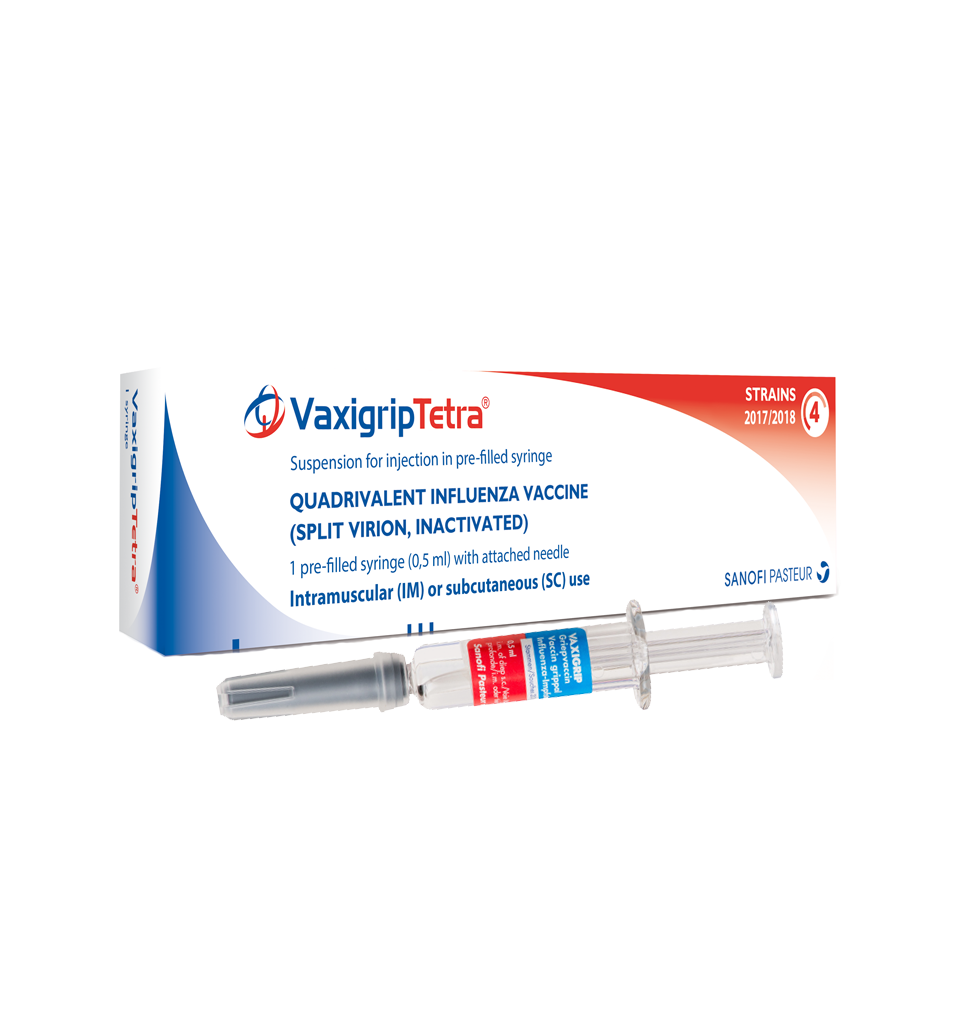This website uses cookies so that we can provide you with the best user experience possible. Cookie information is stored in your browser and performs functions such as recognising you when you return to our website and helping our team to understand which sections of the website you find most interesting and useful.
Vaxigrip Tetra
Brand Name :
Vaxigrip Tetra
Generic Name :
Flu Vaccine
Partner :
Sanofi Pasteur

Download
Vaxigrip Tetra Leaflet

What is this drug and what is it used for?
Pharmacotherapeutic group: influenza vaccine- ATC code: J07BB02.
VaxigripTetra is a vaccine. This vaccine helps to protect you or your child against influenza (flu).
The use of VaxigripTetra should be based on official recommendations. When a person is given VaxigripTetra, the immune system (the body’s natural defence system) will produce its own protection (antibodies) against the disease. None of the ingredients in the vaccine can cause flu.
Flu is a disease that can spread rapidly and is caused by different types of strains that can change every year. Due to this potential change in circulating strains on a yearly basis, as well as the duration of protection intended by vaccine, vaccination is recommended every year. The greatest risk of catching flu is during the cold months, between October and March. If you or your child were not vaccinated in the autumn, it is still sensible to be vaccinated up until the spring since you run the risk of catching flu until then. Your doctor will be able to recommend the best time to be vaccinated.
VaxigripTetra is intended to protect you or your child against the four strains of virus contained in the vaccine about 2 to 3 weeks after the injection. In addition, if you or your child are exposed to flu immediately before or after your vaccination, you or your child could still develop the illness as the incubation period for flu is a few days.
The vaccine will not protect you or your child against the common cold, even though some of the symptoms are similar to flu.
How is this drug given?
Your doctor or nurse will administer the recommended dose of the vaccine as an injection into the muscle or under the skin.
When Is It Given?
VAXIGRIP should be given annually.
Adults:
One 0.5 ml dose
Children:
Children from 6 months to 17 years of age receive one 0.5 ml dose.
If your child is less than 9 years old and has not been previously vaccinated against flu, a second dose of 0.5 ml should be given alter an interval of at least 4 weeks.
Possible side effects
Like all medicines, this vaccine can cause side effects, although not everybody gets them.
Allergic reactions
See a doctor immediately if you or your child experience:
- Severe allergic reactions:
That may lead to medical emergency with low blood pressure, rapid shallow breathing, rapid heart rate and weak pulse, cold, clammy skin, dizziness, that may lead to collapse(shock).
These side effects were not observed with VaxigripTetra but have been rarely reported with other vaccines given to prevent flu (may affect up to 1 in 1,000 people).
- swelling most apparent in the head and neck, including the face, lips, tongue, throat or any other part of the body and which may cause difficulty in swallowing or breathing (angioedema).
Allergic reactions such as skin reactions that may spread throughout the body including itching, hives, rash, redness.
These side effects are rare (may affect up to 1 in 1,000 people) except itching (pruritus) that may be more frequent (may affect up to 1 in 100 people).
Other side effects reported in adults and elderly
Very common (may affect morethan1 in 10 people):
- Headache, muscular pain(myalgia). Malaise, pain the injection site.
Common (may affect up to 1 in 10 people):
- Fever, shivering, reactions at the injection site: redness (erythema), swelling, hardness (induration).
Uncommon in elderly
Uncommon (may affect up to 1 in100people):
- Dizziness, diarrhea, nausea, fatigue, reactions at the injection site: bruising (ecchymosis), itching (pruritus), and warmth.
Rare in adults Rare in elderly
- Hot flush: only seen in the elderly.
- Swelling of the glands in the neck, armpit or groin (lymphadenopathy):
only see in adults.
Rare (may affect up to1 in 1,000 people):
Anomalies in the perception of touch, pain, heat and cold (paraesthesia), sleepiness, increased sweating (hyperhidrosis), unusual tiredness and weakness(asthenia), flu-like illness.
Joint pain(arthralgia), discomfort at the injection site: only seen in adults.
Other side effects reported in children from 3 to 17 years of age
Very common (may affect more than 1 in 10 people): Headache, muscular pain (myalgia), malaise, shivering, reactions at the injection site: pain. swelling redness(erythema), hardness (induration).












